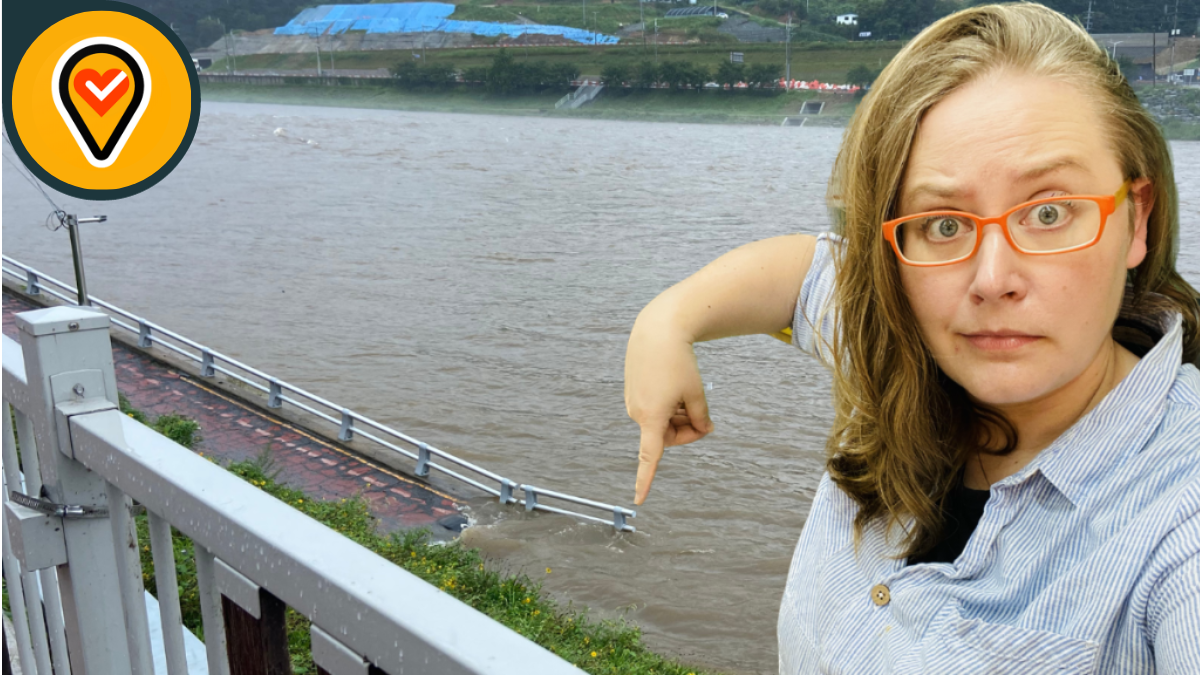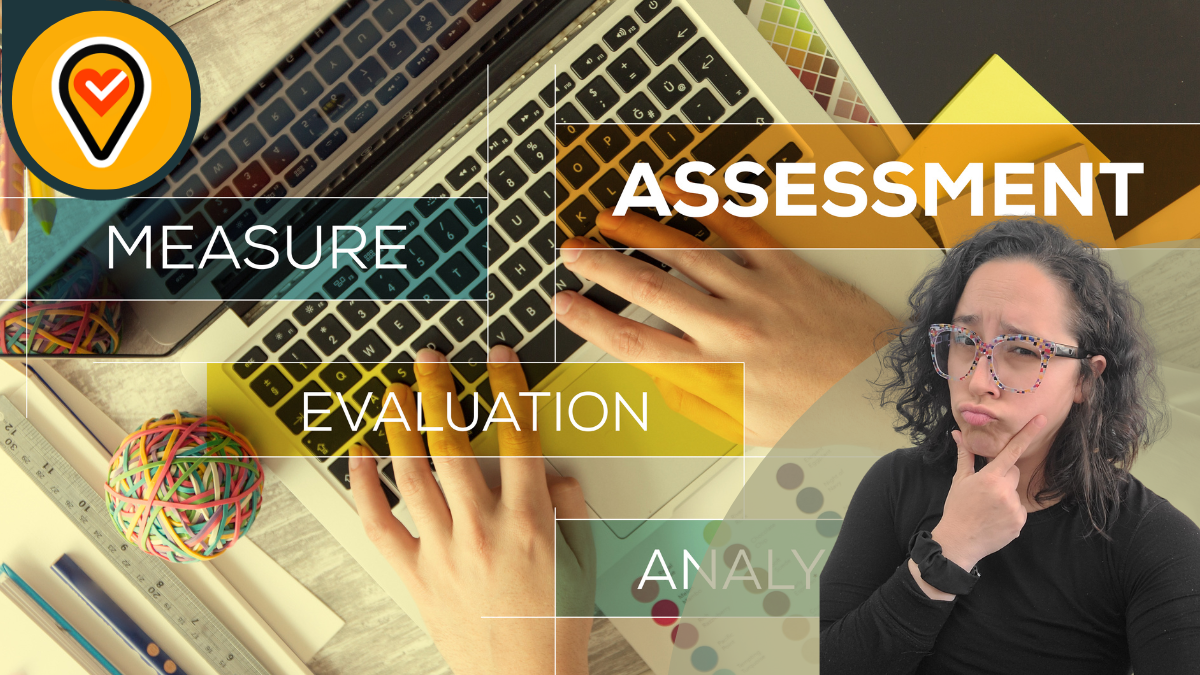
Emergency Shelters in Korea
Do you need help finding emergency shelters in Korea? We’ve got you!
- Importance of Emergency Shelters in South Korea
- Access to Emergency Shelters
- What Is an Emergency Shelter?
- When Are Shelters Used?
- Where Are Shelters Located?
- Types of Emergency Shelters in Korea
- How Will You Know to Go?
- What Happens at a Shelter?
- How to Find an Emergency Shelter
- Helpful Korean Terms
- Conclusion
Importance of Emergency Shelters in South Korea
If you live in South Korea, it’s important to know what to do in an emergency. Natural disasters such as floods, fires earthquakes – as well as civil emergencies such as military threats – can happen anywhere and at anytime. Not only can they happen, the happen often across the country. You NEED to have a plan in place for when you need a shelter.
Access to Emergency Shelters
In emergency situations, the South Korean government provides access to designated emergency shelters called 대피소 (daepiso). Designated places where people can evacuate temporarily and stay safe until the danger has passed.
In the following post we will talk about:
- What emergency shelters in Korea are
- When and why they are used
- Where to find them
- What to expect if you ever need one
What Is an Emergency Shelter?
An emergency shelter is a safe public place where people can go to avoid danger during a disaster or emergency.
These shelters are temporary. People stay there only until it’s safe to return home. Shelters are open to everyone, including:
- Korean citizens
- Foreign residents
- Visitors and tourists

When Are Shelters Used?
The government encourages residents and citizens to use emergency shelters during:
- Earthquakes
- Typhoons and floods
- Large fires
- Chemical or gas leaks
- Missile threats or civil defense drills
In most situations, the government will send out smart phone alerts telling people to evacuate to the nearest shelter. While official alerts often include instructions to move to a nearby shelter, not all emergencies are the same.
Available When You Feel At Risk
Keep in mind, there emergencies may occur on a smaller scale or without the government releasing an alert. If you feel at risk (even without a clear order) you’re allowed to go to a 대피소 (daepiso) for safety and support. It might feel awkward, but don’t let that hold you back. Take yourself to safety. If you are worried, take pictures of the issues that you need to escape to show to the people at the daepiso you intend to shelter at.
Where Are Shelters Located?
Emergency shelters in Korea are usually inside public buildings, such as:
- Schools
- Community centers
- Government buildings
- Subway stations
- Underground parking garages
- Apartment basements
Look for signs that say 대피소 (pronounced dae-pi-so), often printed in red or green and white (as shown below). Also, remember that when it’s flooding you might not want to go to a daepiso in a submerged area like a basement. Choose one on higher land.


Types of Emergency Shelters in Korea
Not all emergency shelters are the same. Korea has different types of shelters depending on the type of emergency. Each type of shelter is located in specific buildings and may have different facilities or levels of protection.
Here are the some of the main types of emergency shelters you may see in Korea:
| Type of Shelter | Korean Name | When Used |
|---|---|---|
| General shelter | 대피소 | Most types of emergencies |
| Earthquake shelter | 지진 대피소 | Earthquakes and aftershocks |
| Civil defense shelter | 민방위 대피소 | Missile threats or war drills |
| Temporary shelter | 임시 대피소 | Short-term situations (fire, flood) |
| Cooling shelter | 무더위 쉼터 | Heatwaves in summer (for vulnerable people) |
How Will You Know to Go?
South Korea has a well-developed emergency alert system. You may learn about an emergency through:
- Emergency text messages (긴급재난문자) sent to your phone (you may need to turn your alerts on or download the emergency readiness app to access these messages)
- Sirens or public announcement systems in your neighborhood
- Safety Korea App (안전디딤돌) with real-time updates and shelter locations
- TV or radio alerts during major events
In many cases, alerts will tell you where to go and what to do. In fact, sometimes including whether to use a 대피소 (daepiso). If this occurs, please act quickly to follow the evacuation notice.
Even if the alert doesn’t mention shelters, you may still be able to access the nearest one if you feel unsafe, need help, or want to wait until the situation improves. Not all locations may be actively functioning as shelters at all times. However, many emergency shelters are located in public buildings (like government buildings or community centers) that may be open during typical business hours (9am – 5pm).
Shelters are open to everyone
We can’t say this enough, everyone in Korea has access to shelters including foreigners, and they do not require ID or permission to enter during an emergency.
What Happens at a Shelter?
The emergency shelter setup is designed for short-term safety and shelter, not long-term comfort, but it offers a secure place to wait until the danger passes. This means you may have access to very few comforts and many people also share the space.
If you go to a shelter during an active emergency, here’s what you might expect:
- Local officials or trained volunteers may be there to assist citizens and residents
- You may receive water, blankets, first aid, and a floor mat if available
- Emergency updates may be announced regularly to keep you informed
- You can rest in a safe space until the danger is over
Important to know:
- You don’t need an ID to enter
- You don’t need to register ahead of time
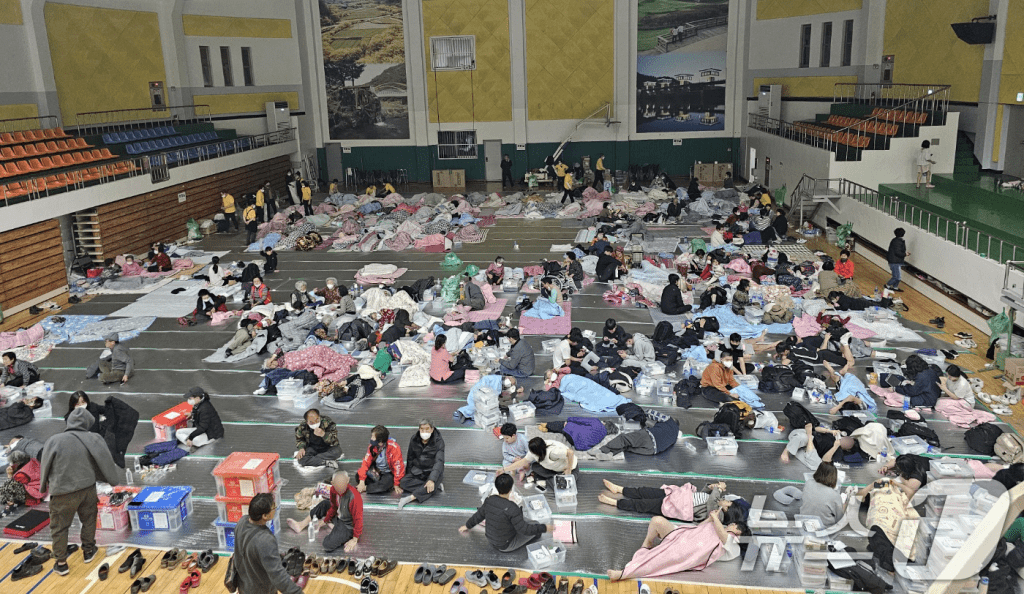
How to Find an Emergency Shelter
Here are the a few ways to locate shelters near you:
Option 1: Use the Safety Korea App
App name: 안전디딤돌 (Anjeon Didimdol)
Language: Korean only
Platforms: Android | iOS
Features:
- Real-time emergency alerts
- Maps showing nearby emergency shelters
- Information about disasters and civil defense drills
⚠️ Note: The app is only available in Korean. If you don’t speak Korean, use a translation app like Papago or Google Translate with camera mode to navigate menus.

Option 2: Use a Map App
You can also search on Naver Map or Kakao Map:
- Type or copy and paste the keywords listed in the “Helpful Korean Terms” section below. For example,
대피소(shelter) or지진 대피소(earthquake shelter) - Add your city name to your keyword search: (Example:
평택시 대피소= Pyeongtaek City shelter)
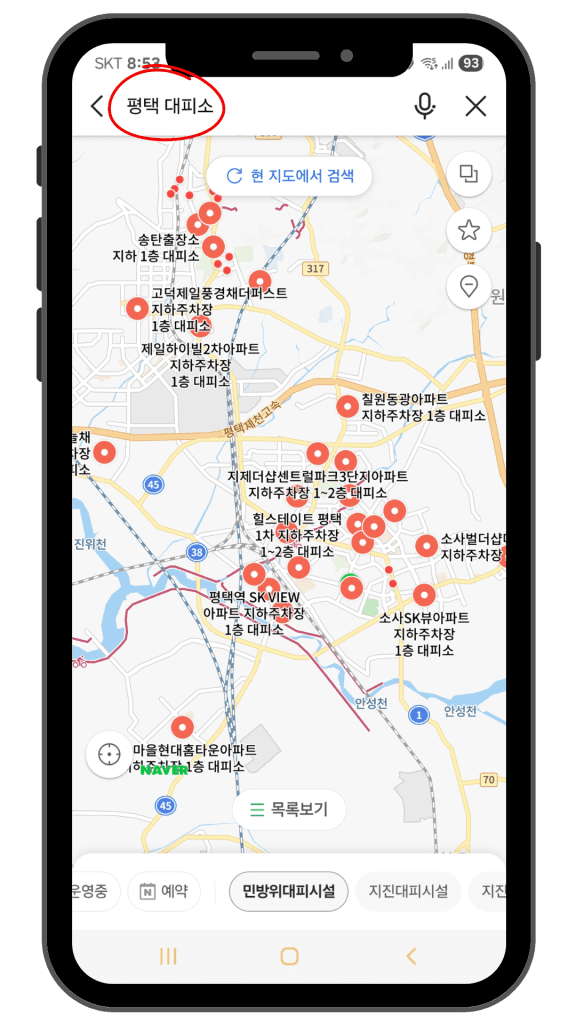
Option 3: Check City Websites
Most Korean cities and counties have official government websites where they post:
- Emergency shelter maps (대피소 안내)
- Disaster updates (재난안전)
- Weather alerts or road closures
- Public health alerts
These websites are mostly in Korean, but you can access the information using browser translation tools. Some city websites have an English version of the site available. However, the English version may have limited inforamation, so it is often best to search the Korean version of the city website.
How to Search for Your City’s Website
Use this format in Google Search:
[City name in Korean] + 시청 홈페이지 (city hall homepage)
For example, 평택시 홈페이지 (Pyeongtaek City homepage)
Then, search 대피소 on the city homepage to find more information about shelters in your area.
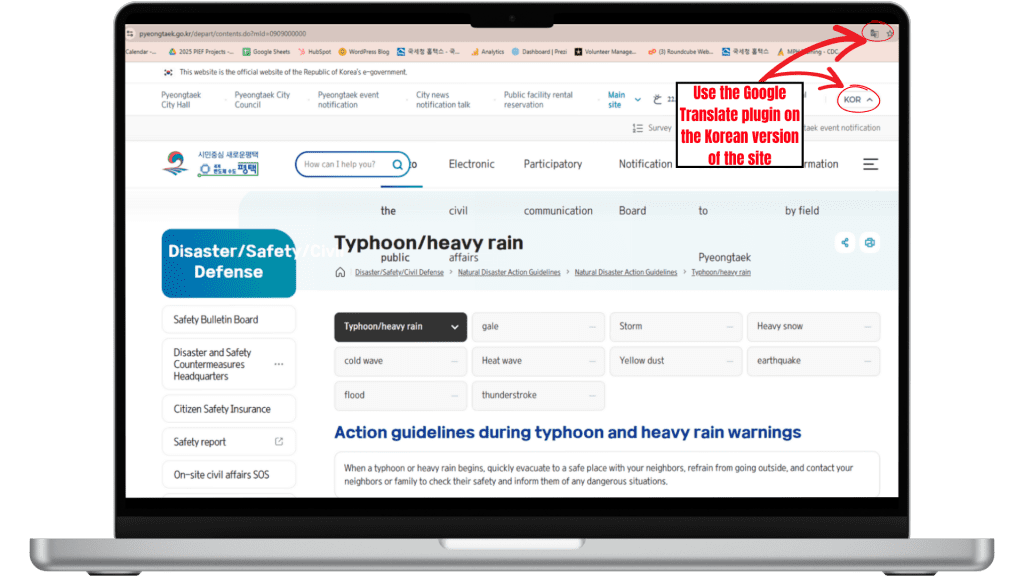
Option 4: Call for Help with Evacuation
119 – Fire, Medical, and Natural Disaster Emergencies
- Korea’s version of 911
- Use for: fires, ambulance, disaster evacuation, rescues
- 24/7 service, nationwide
- Ask for English (영어 [young-uh]) if needed
120 – City Information & Local Services
- For non-emergency help from your local government
- Use for: shelter info, lost items, noise complaints, public services
- May offer multilingual support in larger cities like Seoul
1330 – Korea Travel Helpline
- Operated by the Korea Tourism Organization
- 24/7, multilingual support
- Use for:
- General emergency guidance
- Help finding government contacts
- Directions to emergency shelters
Languages supported: English, Chinese, Japanese, Russian, Vietnamese, Thai, Malay, Indonesian, etc.
✅ This is often the best number to call if you’re not sure who to contact.
Helpful Korean Terms
If you’re looking for shelter information online, asking for help, or reading emergency signs in public places, it helps to know a few Korean keywords. The following terms are commonly used on government websites, apps, signs, and alerts related to emergency safety.
| English Term | Korean (Hangul) |
|---|---|
| Emergency shelter | 대피소 |
| Earthquake shelter | 지진 대피소 |
| Civil defense shelter | 민방위 대피소 |
| Cooling center (summer) | 무더위 쉼터 |
| Shelter map | 대피소 지도 |
| Evacuation area | 대피 장소 |
| Temporary Shelter | 임시 대피소 (limited locations listed on Naver and Kakao Maps – call 1330 to find more locations) |
Conclusion
Emergencies can be stressful, especially in a foreign country where the language and systems may feel unfamiliar. Fortunately, South Korea has a well-organized network of emergency shelters and support systems in place to help keep residents and visitors safe. By learning what emergency shelters are, how to find them, and what to expect if you ever need to use one, you can feel more prepared and confident. Whether it’s a natural disaster, civil alert, or extreme weather, knowing your options ahead of time can make a real difference. Stay safe, stay informed, and don’t hesitate to reach out for help when you need it.

Ms. Peck graduated from the University of Utah Asia Campus (UAC) in Incheon with a Master’s in Public Health and her Certification in Public Health (CPH). Ms. Peck also holds a Bachelor’s Degrees in Linguistics and one in International Studies with a Global Health emphasis.
Ms. Peck is Korean American and speaks both English and Korean. She has moved between the US and Korea since childhood, finally settling in Korea after graduating from UAC.
In 2021 Ms. Peck founded the South of Seoul Public Health Program which focuses on research and initiatives regarding the health and wellness of multinational residents in South Korea.
Additionally, Ms. Peck oversees the SOS Public Health Graduate Student Practicum Program which provides mentorship and training for Master’s in Public Health students. The program works with two students a semester with a focus on ethical UX research design, survey development, and initiative implementation.



